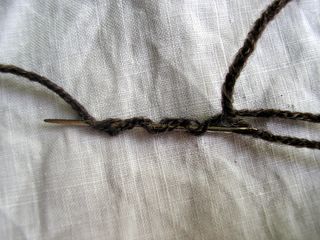Russian Join
So how do you join yarn? Unless you are knitting from a cone, there will come a time when you need to join in new yarn. Some books tell you to do it at the edge. I've never really been a believer in this method. I think it makes the edges wonky. (That's a technical term.) "Oh, but you can hide it in the seam!", they protest. Well, you can but it makes the seam even more bulky and if I've gone to all the trouble of reading Montse Stanley's "Handknitter's Handbook" and picking the best selvedge for the job, I don't want to make a horlicks (another technical term) by joining yarn there. Also, since I don't really do sewing, I am often knitting in the round and there is no edge.
So, how do you join yarn? It depends on what yarn we are dealing with. For 100% wool I use the spit-splice. Just overlap the ends in your palm; use saliva (that's spit, to you and me) to wet the yarn thoroughly; rub palms together vigorously and there you have it. This is the join I used for the buttonhole bags. I think the join is fairly strong but the added bonus here is that the bags are going to be felted anyway, so what the heck.
For really skinny (you don't need me to tell you what sort of a term that is) yarn I just use the two strands together for a few stitches. You need to weave in the two ends when you have finished and you need to choose where the two ends will fall. If it's lace knitting (and it often is) I try to leave the ends where there are decreases, so the ends can be well hidden, and not where there are increases, which is a whole load of holes. I used this join on Birch and all the stuff I've done using Kidsilk Haze. It's so skinny that the extra bulk is hardly noticeable. You do, however, have to remember that this is what you have done. When it comes to working the next row there will be two strands of yarn making up each stitch where you did this. Do not take you eye off the ball or you will find that the stitch count is way off and you will have no idea why. Do not bother to ask me how I know this.
For slightly fatter stuff that is plied you can untwist the plys; cut off half of them at varying lengths and then re-twist the plys with the other piece of yarn, which you have treated in a similar manner. I have used this join but I can never make it look decent - the cut-off plys always seem to stick out and look messy to me.
My "join of choice" for the Highland Triangle Shawl is the Russian Join (and I've been getting quite a bit of practice lately, for a found three knots in the last ball of yarn). Why do they do that? "It's all done by machine," said 'im indoors. Yes, and... You're not telling me the machine stops and ties a knot? "No, I suppose not." No. Somebody, somewhere, took the two ends of the yarn in their hands and carefully tied that knot. So that I can just as carefully untie it (because we can't cut the yarn - God forbid that we should need that two inches of yarn at a later stage. You never know.)
Anyway, the Russian Join. When I Googled for this ages ago I came up with very little. I came up with some pictures of people, and there might have been a few animals in there too, doing unspeakable things. I can only assume they were Russian. I couldn't get rid of it: clicking the little "X" didn't work; clicking "Close" didn't work; nothing worked. Eventually, I had to yank the plug out of the wall before a passing offspring caught sight of it and started with the "Why is that man...." questions. So for those of you who don't want the angst of going through all that, I give you my pictures of the Russian Join.
First you take the two ends of yarn and wrap them one around the other:
Once again, ignore the crumpled cloth, you know I don't do ironing.
Then you thread one end into a needle, which should have quite a sharp point, and you do a sort of running stitch through that same bit of yarn:
You do that for two inches or so. It doesn't really matter - as is often the way with cooking you do it until it's done.
You pull the yarn through and jiggle it (technical, very technical) about a bit until it's gripping the other bit of yarn and there isn't a great loop:
Do the selfsame thing on the other bit of yarn and you are done:
That's the complete Russian Join. You may have to pull the ends and do a bit of tweaking but it is never, ever going to come apart. Do be aware of this when you splice the wrong bits together. You will then have to take the scissors to it and you will, almost certainly, need that extra length of yarn (which will be more than two inches now) before you are finished.
Off to do yet another Russian Join.





1 comment:
Hi Kate,
What join would you use for 100% cotton? Mine is DK and mercerized so I'm not sure if a Russian join would work.
Thanks!
Post a Comment